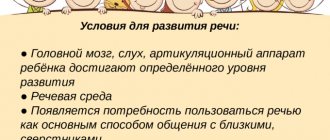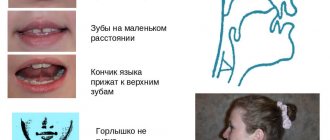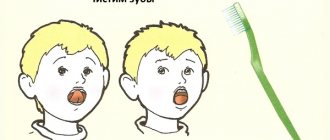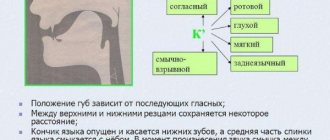When the nervous system is damaged, the connection between the speech apparatus and the central nervous system is disrupted. Dysarthria develops, the mobility of the vocal organs - tongue, palate, lips - is limited, and articulation slows down. In children, dysarthria is accompanied by underdevelopment of speech, impaired reading and writing ability, and incorrect pronunciation of words. Dysarthria occurs as a consequence of damage to the central nervous system due to cerebral palsy, tumors, neuroinfections, injuries and other diseases. In adults, speech disorder can occur after a stroke, with the development of a brain tumor, with multiple sclerosis, Parkinson's disease, neurosyphilis and other diseases.
The neurological department of the Yusupov Hospital diagnoses and treats various diseases of the nervous system, including demyelizing diseases, Alzheimer's disease, Parkinson's disease, cerebrovascular accidents and other lesions of the nervous system. The rehabilitation center uses modern techniques to restore speech and lost abilities of the patient. To restore brain activity when the nervous system is damaged, physical therapy, exercises on simulators, and classes with a speech therapist are used. Various methods of treatment and rehabilitation are used depending on the age, condition of the patient, and the degree of damage to the central nervous system.
Making the sound "s"
The sound “s” in dysarthria is practiced depending on the complexity of the patient’s speech disorder. In difficult cases, when the patient has impaired hearing and speech, the production of the sound “s” can be done in several ways, with preliminary practice of the sounds “f”, “fa”. The speech therapist teaches the patient how to hold the tongue correctly when exhaling and at the same time pronounce a sound. When making a sound, a special thin blade is used, which is used to lightly press the tongue while exhaling and practicing the sound. This is how you can produce whistling sounds for dysarthria (anterior lingual teeth, fricative “z” and “s”). Whistling sounds are formed by a stream of air passing through the organs of speech and resembling a whistle.
When whistling sounds are produced, the air stream passes through a narrow gap that forms between the front of the tongue and the hard palate. The reference sound for the production of “s” is the sound “i”. Therefore, classes include pronunciation of the sound “i”. The doctor suggests hiding your tongue behind your teeth and smiling broadly to say “i-i-i.” Then the doctor and the patient pronounce words containing the sound “and”, the speech therapist uses various exercises. The production of the sound “s” begins after carrying out exercises with the sound “i” in various ways. Having clenched your teeth and smiling, you should silently say the sound “and”, then imagine that you are blowing on the ball. The lips should not close; the tip of the tongue should be behind the lower teeth. During the exercise, the sound “s” is heard.
The second method is performed with the help of a mechanical assistant. The tip of the tongue is located behind the lower teeth, the teeth are exposed in a smile, a thin stick is placed on the tip of the tongue, lightly pressing the tongue. The stick forms a groove in the center of the tongue. The doctor invites the patient to blow on the tip of the tongue with a strong air stream. The sound "s" is heard. In order for the exercise to be successful, you should bring the back of your hand to your mouth and watch the air stream - it should be cool and narrow. When the patient begins to pronounce the sound well, they move on to automating the sound in sentences and words.
When the tongue is finally strengthened in this position, you can gradually move its tip behind the lower incisors, and the temporary lisping pronunciation will be replaced by a correctly articulated s.
The technique used by some speech therapists - clamping the wings of the nose in the process of correcting nasal sigmatism - most often does not give the desired effect.
Since all the above disadvantages of sound pronunciation with
Almost always apply to the pronunciation of sounds
zkts;
correction of these sounds should be started only after the sound
s has been established.
If the speech therapist does not sound the sound z,
a speech therapist can use the technique of tactile vibration of the larynx, and in the future, with the appearance of the correct sound of z, more attention should be paid to oral and written exercises on differentiating voiced z and voiceless
s.
Staging hissing sounds
The listed types of sigmatism, in addition to hissing (interdental, labial-dental, subdental, lateral and nasal), can also occur in the group of hissing sounds (w, zh, h, sch).
In addition, hissing sounds are often replaced by whistling sounds, for example the sound sh
- with the sound
s,
the sound
w
- with the sound z, the sound
h
- with the
c,
the sound
u
- with the sound
s'.
This replacement is called whistling sigmatism.
Disadvantages of pronouncing hissing sounds sh and z
can be eliminated as follows.
The speech therapist suggests that the speech pathologist pronounce the sound siv at this time, bringing a spatula or probe under the tip of the tongue, lifting it by the upper alveoli; in this position, instead of s,
the sound is heard
, w,
instead of z,
zh.
The speech therapist gradually teaches the speech pathologist to hold the tongue in this position. At the same time, in order to ensure the necessary extension of the lips, the speech therapist lightly presses on the corners of his mouth (Fig. 25). Subsequently, the speech therapist reinforces the correct pronunciation of the sounds sh and z in syllables, words and phrases, using a mirror to control the position of his lips and tongue. In addition, he performs oral and written exercises to differentiate between these sounds and the sibilants s and z.
When setting the affricate h
The speech therapist suggests that the speech pathologist pronounce the syllable
at
and at this time, placing a spatula or probe under the front edge of the tongue, lifts it to the alveoli of the upper incisors.
At the same time, the speech therapist lightly presses his fingers on the corners of the mouth, pushing the lips forward. With this position of the tongue and lips, instead of the syllable at
one hears
ach,
instead of
ot
,
och,
instead of
ut
,
uch
, etc.
As the speech therapist consolidates this sound in his kinesthetic and auditory representation, he begins to pronounce it independently (without mechanical assistance) in backward and forward syllables, and then in words and phrases. In addition, oral and written exercises are needed to differentiate this sound and the sounds s
and
ts.
Setting the sound “d”, sound “t” and “t”
Stating the sound “t” for dysarthria and “d” begins with exercises for the tongue, which help increase its flexibility and relieve tone. The patient raises the tongue up, touching the tip of the tongue to the palate, the tongue is directed to the right, to the left, and speech therapy gymnastics is performed. Then the doctor suggests tapping with a hammer (tongue). The patient makes the sound “t” by raising the tongue to the palate and moving it forward between the front teeth. A soft consonant is produced by raising the tongue closer to the roof of the mouth, creating a narrower passage for air to escape than a hard consonant.
The production of the sound “th” for dysarthria is carried out using the method of pronunciation of a soft consonant sound. A speech therapist works with the patient on the pronunciation of soft and hard consonant sounds. Using a spatula, the doctor presses the tip of the tongue, lowers it behind the lower teeth, the child pronounces the syllable “ta” - the result is “cha”. The doctor asks the child to click his tongue. Then the child exhales while clicking, rather than inhaling air - the sound “ti” is obtained. To enhance softness, the sound “t” is pronounced between two vowels.
When pronouncing the sound “d,” the vocal folds close, the palate lowers, and vibration is felt in the larynx. The sound “d” can be produced in several ways: by imitation, from the sound “b”, from the sound “t”. From the sound “t”: the doctor places one of the child’s hands on his larynx, the other on the child’s larynx. Then he pronounces the sounds “t” and “d” in turn, asking to pay attention to the difference in the vibration of the larynx when pronouncing the sounds. Draws attention to vibration when pronouncing the sound “d”. From the sound “b”: The tip of the child’s tongue is located between the teeth. The doctor asks to pronounce the syllables “ba-ba-ba”, at the moment of pronunciation he parts the child’s lips - the syllables “da-da-da” are heard.
Making the sound "n"
Articulation and production of the sound “n” is carried out. During articulation, the lips are in a neutral position, the tip of the tongue touches the upper teeth, and vibration occurs in the nasal cavity when pronouncing a sound. Sound production is carried out using two methods: imitation and from the sound “m”. Method of imitation: the child touches his nose with a finger of one hand, and the doctor’s nose with a finger of the other hand. The doctor shows the position of the tongue in the mouth while pronouncing the sound. The child feels the vibration and tries to repeat it.
Method for the sound “m”: the child’s tongue is inserted between closed lips, the child pronounces a drawn-out “m”. A hint of the sound “n” is heard. As you get used to the interlabial pronunciation of the sound “n” in words, the lips are parted with your fingers. The tongue is then moved to its normal position towards the upper teeth.
A complex of articulatory gymnastics for developing the correct pronunciation of hissing sounds
For articulation gymnastics you will need a mirror, cotton wool and... candy!
Each articulatory gymnastics exercise is performed 3-5 times for 5-10 seconds. The whole complex is done 3-5 times a day for 5-6 minutes .
You can watch the exercises of the complex performed in a demonstration by adults in the video of the “Spread your Wings” foundation.
Punish the naughty tongue. Open your mouth slightly, calmly place your tongue on your lower lip and, smacking it with your lips, pronounce the sounds five-five-five... Keep your wide tongue in a calm position, with your mouth open, counting from one to five to ten.
Make your tongue broad. Smile, open your mouth slightly, place the wide front edge of your tongue on your lower lip. Hold it in this position for a count of one to five to ten.
Glue on some candy. Place the wide tip of your tongue on your lower lip. Place a thin piece of toffee on the very edge of your tongue and glue a piece of candy to the roof of your mouth behind your upper teeth.
Fungus. Smile, show your teeth, open your mouth slightly and, pressing your wide tongue with its entire plane to the palate, open your mouth wide. (The tongue will resemble a thin mushroom cap, and the stretched hyoid ligament will resemble its stem.)
Who will kick the ball further? Smile, place the wide front edge of your tongue on your lower lip and, as if pronouncing the sound f for a long time, blow the cotton wool onto the opposite edge of the table.
Delicious jam. Open your mouth slightly and lick your upper lip with the wide front edge of your tongue, moving your tongue from top to bottom, but not from side to side.
Harmonic. Smile, open your mouth slightly, stick your tongue to the roof of your mouth and, without lowering your tongue, close and open your mouth (just as the bellows of an accordion stretch, so does the hyoid frenulum stretch). The lips are in a smiling position. When repeating the exercise, you should try to open your mouth wider and wider and keep your tongue in the upper position longer.
Focus. Smile, open your mouth slightly, place the wide front edge of your tongue on your upper lip so that its side edges are pressed together and there is a groove in the middle of your tongue, and blow off the cotton wool placed on the tip of your nose. The air should go in the middle of the tongue, then the fleece will fly up.
Cup. After the child learns to spread his tongue and make it wide, has mastered the tasty jam exercise, offer him: “Open your mouth slightly, make a cup out of your tongue, like I did, and place it on the tubercles behind the upper teeth. Now blow on your tongue. Do you hear how the wind rustled? Air passing through a small gap between the front edge of the tongue and the palate produces the sound sh.
Making the sound "l"
Incorrect pronunciation of the “l” sound or omission of the “l” sound is called lambdacism. There are several types of lambdacism:
- When pronouncing the sound “l”, the sound “u” is heard - bilabial type.
- The root part of the tongue falls on the soft palate; when pronouncing sounds, the air flow goes through the nose and changes the sound “l” to “ng”, speech becomes nasal - nasal type.
- During the pronunciation of sounds, the tip of the tongue moves into the interdental space - interdental type.
- The sound “l” is not pronounced at all.
A child may not pronounce the sound “l” for several reasons:
- The child has a short hypoglossal ligament.
- The muscle tissue of the tongue is weakened.
- The child does not perceive the sound “l”, phonemic hearing is impaired.
Preparation for producing the “l” sound for dysarthria begins with articulation. The organs of articulation – lips, palate, tongue – should be positioned correctly. The teeth should not close together, the tip of the tongue should rest against the upper gums or teeth, it should be tense. The upper palate and the root of the tongue should be raised, vibration is created in the area of the vocal folds. The production of sound depends on the type of lambdacism. With bilabial lambdacism, sound pronunciation is impaired due to incorrect positioning of the lips. In this case, use the exercise with a smile, the teeth are clenched and the lips part in a smile. The speech therapist conducts articulation gymnastics with the child, activities during which lip tension is relieved. Also, the sound “l” can be made by imitation. The speech therapist shows the child the correct position of the lips, tongue, teeth and pronounces the sound. At this time, the child’s palm is placed on the doctor’s cheek, and he feels the vibration being created. The sound “l” refers to complex sounds, the production of which is formed by the age of 6 years of a child’s life.
Sibilants in a child's speech
Hissing ones include - [w], [zh], [h`], [sch`]. The formation of their correct pronunciation occurs between the third and fifth years of the baby’s life.
Incorrect pronunciation of “Sh”: types, reasons
Distortion or complete absence of sibilants in a child’s speech is called sigmatism. Depending on the type of incorrect placement, there are 4 types of sigmatism:
- Parasigmatism is a stable replacement of [sh] with another sound. Labial-dental - dental - replacement of [w] with [f]. Prizubny - replacing [w] with [t]. Hissing - replacing [w] with [sch]. Whistling - replacing [w] with [s] or [z]. Occurs with malocclusion or impaired phonemic hearing. Example: hat - slipper.
- Interdental sigmatism is the same “lisping” sound. Occurs due to a shortened frenulum or narrow soft palate.
Lesson with a specialist
- Lateral sigmatism - the sound [w] does not sound firm, as it should, but squelching, as if the baby had taken water into his mouth. Observed due to lateral open bite or weak tongue muscles.
- Nasal sigmatism - in a preschooler, the back of the tongue becomes very tense, and [w] can be pronounced with a nasal “echo.”
Before figuring out how to teach a child to pronounce the letter w, you should understand the reasons for the violation. Often a routine visit to the orthodontist, during which the bite or upper palate is corrected, ends with the long-awaited “hissing” of the baby. Otherwise, there is a need to develop the correct articulation pattern in speech therapy classes.
Articulation gymnastics for staging hissing
Before requiring the baby to pronounce a hissing sound, it is necessary to carry out preparatory articulatory gymnastics. Its duration is no more than 10 minutes. Despite the fast pace (so that the preschooler does not get bored), the child must perform each exercise carefully, since gymnastics directly determines how quickly a child can learn to say the sound [w].
Main tasks in articulatory gymnastics:
- Fence - a wide smile with teeth.
- Tube - the lips are gathered into a tube, there is a small gap between the lips.
- Alternating fence - tube.
- Hippopotamus - open your mouth wide and hold it for a while.
- Spatula - place a wide, outstretched tongue on the lower lip. You can “bite” with your tongue to make it wider.
- Homemade jam: lick the upper and then the lower lip with the tip of your tongue.
- Brush - move the tip of your tongue across the soft palate - from the throat to the teeth and back.
Articulation gymnastics
Tasks to determine the position of a sound in a word
At the beginning of the lesson, you can also develop phonemic awareness - determine the position of a sound in a word. To do this, you will need rich verbal and subject material.
- The child is asked to clap if he hears the “snake song (sound [sh]).” In this case, words are pronounced that contain the desired sound or do not contain them. You should not pronounce words with other hissing or mixed whistling sounds.
- The child is given a small sign with 3 windows indicating the beginning, middle and end of the word. And also a chip (cube/drawn sound). The teacher says the condition: “I will name the word, and you put the chip where the sound [w] is located.”
Setting the T sound
Gymnastics for clear pronunciation
To correctly pronounce hissing sounds, speech therapy uses articulation and breathing exercises in combination. In this case, you should definitely remember about the correct position of the organs of articulation: lips and tongue.
Additional Information! Breathing exercises are aimed at developing smooth exhalation. To teach your child to perform breathing exercises, you need to create bright and interesting didactic material. For example, a flower with a butterfly sitting on it, which, according to the terms of the task, needs to be blown away.
Methodological basics for parents
It is important to know the correct position of the tongue and lips when pronouncing a sound in order to work on the exercises at home.
- Lips in the “tube” position;
- The tongue is wide, the tip is raised upward;
- The lateral parts of the tongue are in contact with the teeth of the upper jaw;
- A small gap forms between the palate and the tongue in the area of the upper incisors.
Making the sound “e”, “y” and other vowels
The production of the sound “y” for dysarthria, as well as the sounds “u”, “e”, “o”, “a”, “i” is carried out first. The speech therapist clarifies the articulation of vowel sounds. Then work begins with soft sonars, then with their hard sound pairs. Speech therapy massage, articulation gymnastics, and breathing exercises are performed beforehand. The doctor invites the child to take a deep breath through the nose, open his mouth slightly with a smile, and point the tip of his tongue toward the lower incisors. Exhale and whisper the sound “e”, then repeat the exercise with your voice.
How to make the sound "r"
An experienced speech therapist knows how to make the sound “r” for dysarthria, how to make the process of automating the sound “r” interesting. Making the sound “r” with dysarthria can take a long time. After warming up, the doctor asks the child to memorize the words, then repeat them using pictures. The pictures depict objects, flowers, plants, animals whose names contain the sound “r”. Such activities train memory and correct sound pronunciation. Methods used to make the sound “r”:
- Imitation.
- Through articulation.
- Mechanical assistance: from the reference sound, from the articulatory structure.
Making the sound "th"
The sound “th” refers to the middle lingual, oral, fricative, consonant, voiced, soft sounds. Before setting the sound “th”, speech therapy gymnastics is carried out, then the sound is set by imitation, which is accompanied by tactile sensations and demonstration of articulation. Sound production can be done by pronouncing the sound combinations “ya” at a fast pace, using the sound “z”, pressing the tip of the child’s tongue when pronouncing the sound - the sound “th” is obtained. The sound “th” is heard when the sound “h” is pronounced.
Setting the sound "ts"
The sound “ts” is introduced after the child begins to pronounce the sounds “s” and “t” well. With the rapid repetition and merging of the sounds “t-s”, the sound “ts” is obtained. The sound of the sound “ts” can be achieved by imitation. The child’s palm is brought to the speech therapist’s mouth, the sound “ts” is pronounced with a strong exhalation - the child feels a stream of cold air on his palm. The doctor shows the child the position of the tongue, lips and teeth when pronouncing a sound. Then the child must repeat several times the syllables consisting of the sound combination “ts” and vowels.
When pronouncing a sound, the tip of the tongue rests on the front teeth, the tongue is curved and raised, the lateral edges of the organ are tense. When pronouncing a sound, the tip of the tongue moves away from the front teeth, increasing the flow of air. The part of the tongue adjacent to the palate is lowered. When pronouncing, the teeth are brought together, the lips are stretched into a smile. The air comes out with a push when the palate and tongue open; the palm applied to the mouth feels a strong and cold stream. To consolidate the result, the doctor pronounces tongue twisters with the child and plays games to identify the sound “ts” with his eyes closed.
In case of interdental sigmatism, for good pronunciation of the sound, a spatula or a teaspoon is used, which is used to fix the tip of the tongue on the inside of the lower teeth while pronouncing the sound. The middle part of the tongue should connect to the hard palate. With labiodental sigmatism, the lower lip interferes with the pronunciation of sounds. To ensure the purity of sound pronunciation, the doctor holds the child’s lower lip while the child learns to pronounce forward and backward syllables containing the sound “ts”. The production of the sound “ts” is carried out through daily activities with the child, through games, and pronouncing tongue twisters.
Disturbances in the pronunciation of hissing sounds in children:
First. The absence of hissing sounds in speech or their replacement with the sound t (instead of the word “bear” the child pronounces “mika”, instead of the word “thorn” the child pronounces “type” - replaces it with t).
Possible reasons for this distortion of the sh sound are early age or impaired phonemic hearing.
Second. Replacements with f (fifka - bump).
Possible causes of sound distortion:
violation of phonemic perception., too active lip work, shortened sublingual frenulum. This replacement is called labiodental sigmatism.
Third. Replacing the sound sh with the sound s (for example, instead of “went” the child pronounces “sla”). This replacement is called whistling sigmatism.
Possible reasons for sh sound distortion:
violation of phonemic awareness. When correcting, it is necessary to teach the child to distinguish between whistling and hissing sounds!
Fourth. Lisp. This is due to the fact that, in contrast to the normal position of the organs of articulation, the tongue is pushed between the upper and lower incisors, forming a flat gap with them, the back is lowered and does not form the back of the scoop. The air stream when you bring your palm to your mouth is weak and scattered.
Possible reasons for sh sound distortion:
shortened hyoid ligament, making it difficult to lift the tongue to the palate; high and narrow hard palate. This replacement is called interdental sigmatism.
Fifth. Lateral sigmatism.
In this case, in the words he pronounces, instead of the sound sh
a peculiar squelching sound is heard. One of the corners of the lips is slightly lowered or retracted, there may be a slight shift of the lower jaw to the left or right, the lateral edges of the tongue are also lowered. When you bring your palm to your mouth, the air stream goes to the side (left or right) or comes out along both edges of the tongue, while normally the air stream should go strictly in the middle of the tongue.
Possible causes of sound distortion:
weakness of the muscles of one half of the tongue; lateral open bite.
Sixth. Nasal sigmatism.
In this case, the sound w is replaced by snoring (in the nose) or a sound similar to the deep sound x with a nasal connotation. In contrast to normal articulation, the organs of speech occupy a neutral position, the tongue is lowered down and pulled into the depths of the mouth, the back of the tongue is raised up, connecting to the soft palate, the lateral edges are lowered down. The air stream exits through the nasal cavity and not from the mouth.
Cause of sound distortion
: is excessive tension on the back of the tongue.
Setting the sound "sh"
Setting the sound “ch” for dysarthria and the sound “sh”, “d”, “zh”, “sch”, “ts”, “g”, “b”, “r”, as well as setting the sound “z” for dysarthria carried out in the second stage. Methods for making the sound “sh” for dysarthria are used after the child learns to make a cup with his tongue. The wide tongue rises to the upper teeth, preventing air from passing through the edges. The tip of the tongue forms a gap with the palate. The child should exhale warm air with some effort; vibration should not be created in the larynx. The sound “sh” can be corrected from the sound “r” and the syllable “ksh”. Sound production is carried out using a spatula or spatula, which helps slow down the vibration of the tongue and the result is hissing. Sound production can be done by imitation.
“Home” speech therapy sound [w]
To teach your child to pronounce [w] correctly at home, you need to learn several basic methods of production:
- mechanical;
- from a similar-sounding sound.
Mechanical setting
With this method, the baby does not need to independently search for the correct position of the sound - an adult does this for him, using special speech therapy tools (spatula, probe). If you need to put your hand into a preschooler’s mouth, it must be clean.
Mechanical staging process
Staging through sound [r]
How to learn to say the letter Ш through the sound [r]? It would seem that incorrect pronunciation of [r] is the most complex and most common speech defect. However, many children know how to pronounce [r] correctly, but do not understand at all how to position the tongue in the mouth in order to whistle and hiss correctly. For this reason, the sound should be produced through a solid [r], and not adjacent sibilants.
The preschooler should sit in front of the mirror and pronounce [r], gradually weakening the air pressure. The sound should be pronounced until the vibration completely disappears. After this, a slight hiss will be heard and [w] will sound without the auxiliary [r].
Speech therapy exercises on pronunciation of the sound [sh]
To consolidate the placed [w] in the baby’s speech, it is necessary to speak as much as possible with a separate sound - hiss during the game. For this, the preschooler is offered various exercises:
- move the snake along the path, and hiss at the same time;
- “finish” a word, for example - small ..(sh), karanda ..(sh), etc.
Articulation gymnastics for the sound R
Making the sound "p"
At the first stage of treatment, the sound “p” is automated and the sound “p” is differentiated. The order of sound production depends on the degree of difficulty for pronunciation, the gradual transition from easy to pronounce to difficult to pronounce sounds. The order of sounds will depend on the similarity in articulation and acoustics. The sound “p” is labiodental, oral, plosive, stop, instantaneous, voiceless. At the moment the sound is pronounced, the lips are closed and tense, then the lips open and the air pushes out. There is a small distance between the teeth, the soft palate closes the passage to the nose, the vocal cords are open. Sound production is based on imitation, speech motor rhythms are used.
Staging hissing sounds
Training takes place through classes; methods for producing hissing sounds depend on the diagnosis and the level of psychomotor dysfunction. The principle of an individual approach is used; classes should develop the child emotionally and intellectually. During the production of sounds, visual, auditory and tactile analyzers are connected, motor-kinesthetic, auditory-visual-kinesthetic, and didactic methods are used. Active and passive articulatory gymnastics and massage are performed.
Why doesn't the letter "Ш" hiss?
The reasons for incorrect pronunciation may be the following:
- Physiological: malocclusion, large tongue, high palate. In addition, the quality of the spoken sound depends on the development of the speech apparatus.
- Prolonged use of the pacifier. This item spoils the bite, which leads to distorted pronunciation of whistling and hissing sounds.
- "Lisping" with a child. By repeating after their elders, children distort their speech.
- Repeating incorrect pronunciation after adults who have speech impediments.
- Memory, thinking and attention are poorly developed.
- Speech hearing impairment (in some cases, dyslexia may develop).










